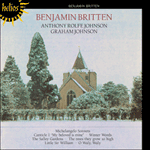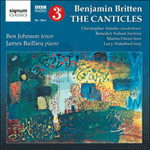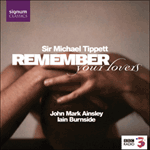Britten’s five
Canticles were composed across a period of some twenty-five years and each is concerned, to a varying extent, with religious themes. Their extended, multi-sectional form derives from the dramatic songs and
Divine Hymns of Purcell, many realizations of which Britten had made before writing his first
Canticle, 'My beloved is mine', in September 1947. It is a setting of a text by Francis Quarles, characteristic of much mystical poetry since
The Song of Songs in its quasi-erotic imagery, which is beautifully caught in Britten’s cantata-like setting – a sequence of barcarolle, recitative, scherzo and lento coda. Writing in 1952, Peter Pears was of the opinion that
Canticle I was ‘Britten’s finest piece of vocal music to date’ and it still compares well with almost anything he wrote later. Much of its quality derives from the expressive and sometimes highly melismatic freedom of vocal writing.
from notes by John Evans © 1986
Le premier Cantique,
My beloved is mine fut écrit en 1947 pour un concert à la mémoire de Dick Sheppard, ancien curé de St Martin-in-the-Fields et fondateur de la Peace Pledge Union, cause chère au compositeur. Britten venait de travailler à des exécutions des «Divine Hymns» de Purcell, et il est naturel qu’il ait eu l’idée de composer une pièce analogue à la mémoire de son ami. Le Cantique, pour voix aiguë et piano, a pour texte «A Divine Rapture», poème de Francis Quarles (1592–1644), dont l’inspiration est une citation du Cantique des Cantiques. Britten omet l’une des strophes originales, et regroupe les six autres (1+2, 3, 4, 5+6) de façon à former un arrangement en quatre mouvements consistant en une barcarolle contrapuntique, un récitatif, un scherzo canonique rapide, et un finale essentiellement en accords. Le texte exprime l’amour divin en utilisant la métaphore de l’amour physique, et chaque strophe s’achève sur une version du refrain «I my best beloved’s am, / So he is mine» («Je suis mon bien-aimé, / Et il est à moi»).
extrait des notes rédigées par Michael Short © 1992
Français: Elisabeth Rhodes
Das I. Canticle
My beloved is mine, wurde 1947 zum Gedenkkonzert für Dick Sheppard komponiert, dem ehemaligen Vikar von St Martin-in-the-Fields und Gründer der Peace Pledge Union, einer Bewegung, für die der Komponist selbst eintrat. Britten hatte kurz zuvor Aufführungen von Purcells Divine Hymns vorbereitet, und die Idee, ein ähnliches Stück zum Andenken an seinen Freund zu komponieren, bietet sich als natürliche Konsequenz daraus an. Das Canticle ist für hohe Stimme und Klavier vertont, und als Text hat der Komponist das Gedicht „A Divine Rapture“ von Francis Quarles (1592–1644) ausgewählt, das selbst von einem Zitat aus dem Hohelied Salomos inspiriert wurde. Britten ließ eine der Originalstrophen aus und ordnete die übrigen sechs nach dem Schema 1+2, 3, 4, 5+6 so an, daß eine viersätzige Komposition aus kontrapunktischer Barkarole, Rezitativ, schnellem kanonischem Scherzo und hauptsächlich akkordischem Finale gebildet wurde. Der Text spricht von göttlicher Liebe, ausgedrückt durch die Metapher fleischlicher Liebe, und jede Strophe endet mit einer Variante des Refrains „I my best beloved’s am, / So he is mine“ („So bin ich dem Geliebten eigen, / Und so ist er mein“).
aus dem Begleittext von Michael Short © 1992
Deutsch: Anne Steeb/Bernd Müller


 Britten: Michelangelo Sonnets & Winter Words
Britten: Michelangelo Sonnets & Winter Words Britten: The Canticles
Britten: The Canticles Tippett: Remember your lovers & other songs
Tippett: Remember your lovers & other songs
